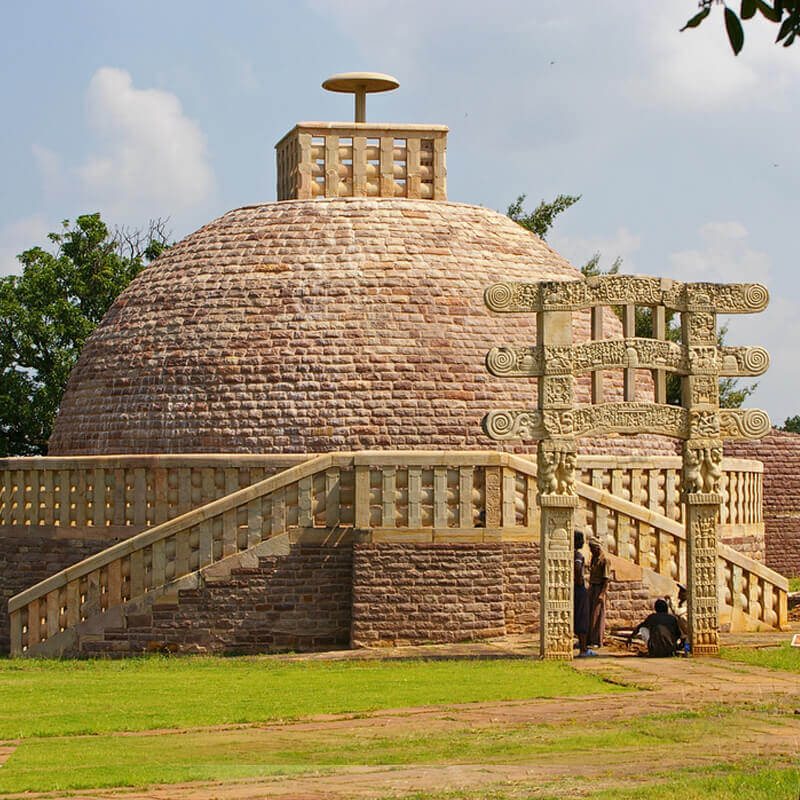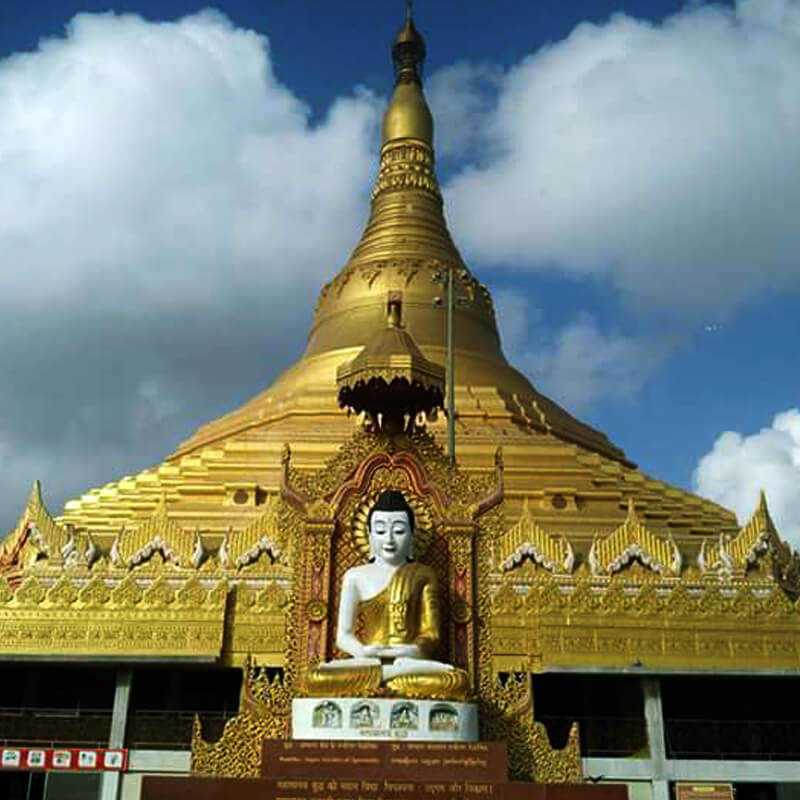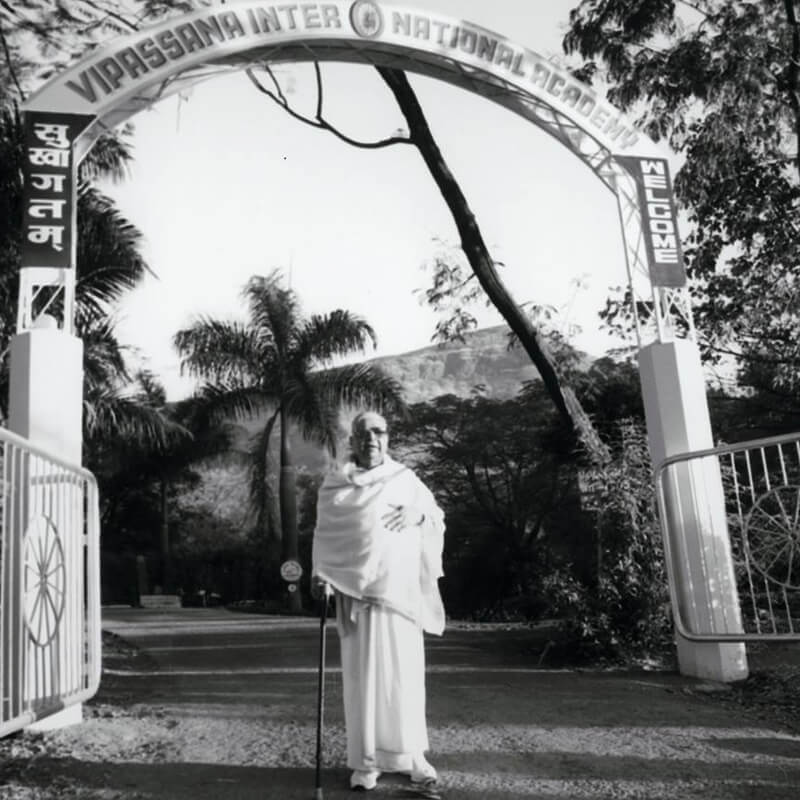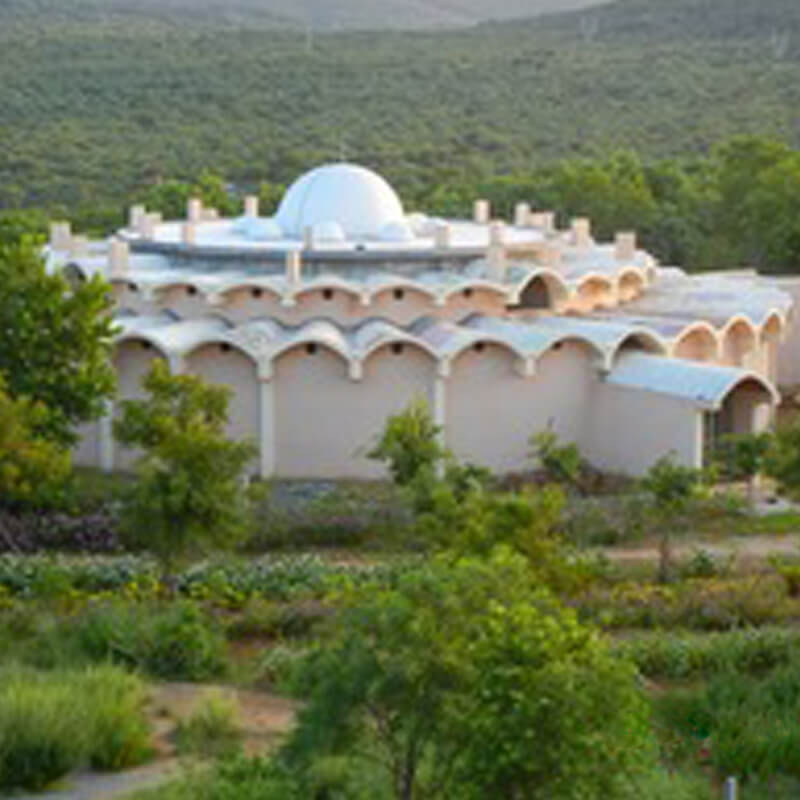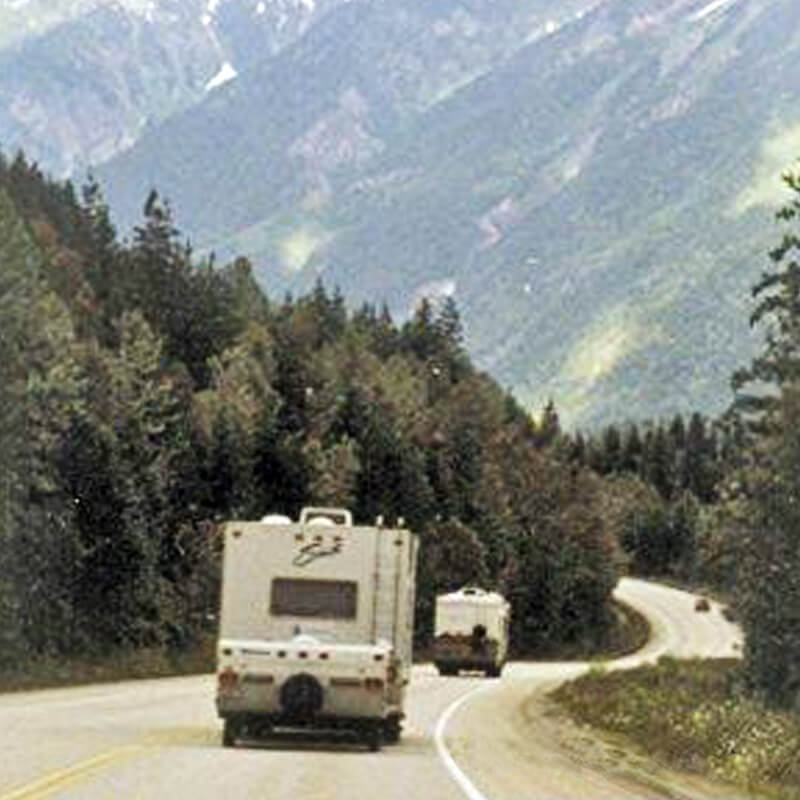First sitting at the new center:
“On the date that the Trust became the new owners of Red House Farm, a small group of meditators moved in. The weather was perfect, a glorious, warm and calm midsummer evening. The gentle countryside was lit up in its finest glow and green. The first sitting was held in a small room in what later became the Dhamma Hall. All sitting is worthwhile but that sitting felt particularly special. An easy sharp awareness flowed through us, no doubt inspired by the deep thrill we felt at such an auspicious inaugural moment. A rare moment connecting one to the possibilities and potential of all that was and still is to come. Afterwards we walked round the boundaries in real peace and joy.”
Early Days
The initial impetus for a Vipassana organization in the U.K. came from a small group of old students who had sat courses with Goenkaji in India during the early 1970s. An informal community of meditators established themselves at Oak Tree House in southeast England. They acted as U.K. contacts and also took responsibility for organizing courses and sending out newsletters. Goenkaji conducted his first U.K. course at a rented site near London in 1979. From 1982 onwards one or two small assistant teacher courses were held every year in outdoor activity centers or hired retreat facilities. Regular Dhamma meetings took place at people’s homes. About 15 students formed the core group; this continued to be the level of involvement until the purchase of a Dhamma house in 1987.
From the beginning the group began actively exploring the possibility of setting up a small permanent meditation facility. However money was only sufficient to support occasional courses at rented sites. The group itself was unable to find a suitable location and for some time the project did not advance. Four summers in a row (1983-86), Goenkaji conducted large 10-day courses at Langley School, in Norfolk. These attracted students from around Europe, and gave many people their first taste of sitting and serving. The seeds for new groups and projects in different countries were also sown here. Early on Goenkaji recommended that U.K. meditators form a legal trust, with members appointed annually by him. This provided a formal structure within which individuals could take on more responsibilities and work together.
Hearing about the difficulties with finding a suitable facility, Goenkaji suggested that the trustees look in Birmingham — England’s second city, with a multi-cultural population. The search proved successful: with generous financial help from meditators in the U.K. and abroad, the Trust purchased a house in the suburbs of the city in January 1987. Goenkaji named it Dhamma Geha, meaning “House of Dhamma.” The first U.K. resident assistant teachers were appointed and the first course for about 30 students was held the following Easter.

City stepping-stone
The three-storey house was designed for a single family but it proved surprisingly adaptable; within a short period, it was being used for monthly 10-day courses. The neighbors must often have wondered what so many people were silently doing next door. Dhamma Geha provided a calm and comfortable environment for meditation, despite the location on a busy road. The only occasional disturbance came as late-night revelers passed by.
The benefits of having even a small permanent facility were felt immediately. The Birmingham house provided a new Dhamma home for U.K. Vipassana meditators. Committed students could sit and serve continuously, precious finances were conserved and built up, and the Trust now had a base for its meetings and Dhamma activities. Goenkaji and Mataji stayed at the house on several occasions. However, within months of moving into Dhamma Geha, plans were already forming to purchase a larger site that could be developed as a full Vipassana center. The search took four years to achieve its goal.
Fast Forward to a Full-Fledged Center
Criteria for the proposed new center were eagerly debated. The details of dozens of properties around Britain were evaluated and many sites visited. None seemed suitable. With some misgivings, the Trust agreed to instruct a specialist property hunter to take up the brief. The decision paid off. Within a few weeks an interesting property was found. A 22-acre residential riding school known as The Marches had come on the market. The farm site was located near Hereford in the border country between England and Wales.
One problem was finance. The Trust began its earlier search for a Dhamma house with just £6,000 ($11,400) in the bank — yet somehow Dhamma Geha had been purchased for £62,000 ($117,800). Only a few years later the Trust was now contemplating an offer on a property priced at over £300,000 ($570,000). It hardly seemed possible. However, the Trust had some important allies. Venerable Dr. Rewatadhamma, a long-time friend of Goenkaji’s from Burma and later appointed a Bhikkhu Teacher of Vipassana, had charge of a small vihara in Birmingham and knew the city and its spiritual organizations well. He heard of the Trust’s wish to move and a Thai vihara’s need for bigger premises. The Thai group bought the Birmingham house and the Trust was able to benefit from a recent surge in property values. Then, in response to a special letter to make known the need for donations and service, the U.K. meditator community rallied round the proposal and many generous pledges of support came in. Regular monthly donations offered by individuals and families provided some much-needed assurance that repayment costs could be covered. A large loan was painstakingly negotiated with the bank, only to be withdrawn as the Trust prepared to complete the deal. Fortunately a meditator businessman took prompt action and persuaded his own bank to offer the Trust a loan on similar terms. The purchase went ahead without further difficulties — and the loan was duly repaid.
Fit for the task?
“In fading evening light, the property looked very different from the agent’s glossy portfolio. The riding school buildings, out of use for two years, were dirty and run-down. The surrounding land seemed barren, wide open to the wind and rain, and very muddy. Hardly the place to invest our future, I thought. Fortunately wiser heads prevailed. Mud is a primitive, highly effective construction material and this was going to be a long-term Dhamma make-over.
“I remember feeling somewhat stunned in the car journeying home. Part of me recognized instantly that this was the place, but what a daunting task it would be to breathe life into the motley collection of shabby, forsaken buildings! Were we up to it? By the end of the evening all my doubts had evaporated and been replaced by a thrilling sense of the potential of what was to be.”
Training Minds, not Horses
The property consisted of a three-bedroom house, a cottage, outbuildings, dormitory blocks and a kitchen/dining block, situated at the end of a private lane. The buildings were clustered in the middle of four large fields, so a division for male and female areas was easily established. The site offered a basic facility for near-immediate use for about 50 people, with tremendous opportunities for phased development over time. The surrounding hilly countryside was sparsely populated and devoted to agriculture and fruit-growing. Though rural, the new center was located in a very accessible area only 10 minutes from the motorway network and midway between the towns of Hereford and Ross on Wye. Major urban centers such as Birmingham, Gloucester, Bristol and Cardiff — all with good U.K. travel connections and international airports — were only one hour away.
The initial challenge was to prepare the site within a month for the first scheduled 10-day course. It happened that Goenkaji had arranged to stop over in the U.K. on his way to North America. He arranged to be at the new center on Day 10 and give Metta instructions to the fortunate students.
Practically nothing on the site was in clean or working order. Horses seemed to have taken priority over people, for the stables were the most substantial buildings. Bands of enthusiastic meditators got to work. Amateurs and professionals applied their practical skills to great effect. Virtually every inch of wall, floor, ceiling and window was given some treatment or other. Slowly something stirred amidst the grime and decay, and four weeks later the seed of Dhamma Dipa had germinated. Meditation hall, dining rooms, kitchen, student dormitories, teachers’ residence, bathing facilities — all had materialized and the center stood ready, with an air of expectancy, to receive its first course participants and their Dhamma Father. To newcomers at that time the center must still have had an air of shabbiness about it, but to those who had seen it on purchase, it sparkled like a shiny new pin.
Goenkaji named the center Dhamma Dipa — “Island of Dhamma.” Speaking to students and Dr. B. and K. Gandhi, the newly appointed teachers for the U.K., he said, “You have chosen a very suitable place. The environment all around is very nice, quiet and peaceful, without the pollution of cities. I am sure this center will grow in Dhamma.”
Progress Made
Now 15 years are over. The approaching anniversary is a good time to reflect on how Dhamma Dipa has grown and changed. What once was a seed bursting with promise and new life is now a strong, maturing tree giving ever more shelter and protection, a tree with ever-deeper roots giving increasingly abundant fruits.
There are the roots of thousands of trees planted in red soil by teams of meditators since the early days, which have yielded woodland walks, a haven for wildlife and a beautiful dawn chorus of birdsong. The edible fruits of the trees and verdant hedgerows — cherries, apples, plums, pears, elderberries, blackberries, mulberries — are all harvested and served with joy to the students. The plantings include a cutting from an ancient yew that dates back to the time of the Buddha.
There are roots of brick and concrete — the foundations and fabric of new and renovated buildings, providing ever more conducive meditation and living facilities for the students. All are the results of the tireless endeavors of many and bear the hallmark of selfless service. Steady progress is being made toward realizing the center development plan. Many of the original farm buildings have been converted and upgraded to provide cells and accommodation, and several new buildings — Dhamma hall, teachers’ bungalows, toilet/shower block — have been completed. Dhamma Dipa can currently accommodate 85 students plus servers; on completion this number will rise to 150, including servers. Plans for the near future include the construction of a new kitchen/dining block and more comfortable rooms with attached bathrooms.
An Early Course
“I returned that autumn (1991) to serve on the first Satipatthana course to be held at the center. There were only four servers on site — the center manager, a male and female course manager, and myself as kitchen manager. Quite a large number of old students were sitting the course. So the female manager and myself did nearly all of the cooking and cleaning, although three male students had volunteered to take turns washing up the dishes after lunch (there was no dishwasher in those days). We were accommodated in a large, cold room that had a broken window and was very drafty. It was hard work but good fun, and I remember joking with the female manager about how we should have many offers of marriage after all our efforts. And in fact, as fate would have it, our future husbands both were sitting on that course, although we did not realize this until a few years later.”
The number of students attending courses at the center is constantly growing. Students come from every background and part of the world; there are well-established links with the U.K. Indian and Burmese communities. Long courses of 20 and 30 days, enabling established meditators to deepen their practice, have been offered since 1996. The body of servers keeps multiplying, and more and more people from the U.K. and beyond come forward to take part in the work of spreading Vipassana. Regional groups of meditators — for instance, in London and East Anglia — are gradually gaining strength. There is the realistic prospect that new U.K. centers will eventually be set up.
Serving Long-Term
“The days here are full with things that from the outside may seem dull and boring, but which take on a pleasure when done in a less egocentric way than I am used to. The practice of serving and giving is somehow not demeaning when everyone is involved in the same way. The center is orientated to the experience of change. Tonight there are four of us here, tomorrow at 6.00 p.m. it will be two, and next week it will be a hundred. But life goes on in a fairly steady way. We meditate three times a day, which means it’s difficult to get stressed for very long. That’s not to say there are no difficulties or differences, but they do seem to get resolved in a way that is mindful and considerate.”
The center’s influence is spreading as more and more meditators come to live in the area. Motivated to integrate Vipassana into their family lives and to serve in whatever ways their circumstances allow, they find homes and work nearby, take an active part in the local community, and so become instruments of Dhamma themselves in their everyday dealings with people.
Local Landmark
“Living and working near Dhamma Dipa, I see at first hand how its presence is permeating the local area. It was a new arrival 15 years ago. Now it is an established resident. I often drive along the nearest road in my busy daily life and take inspiration, when in the distance over the fields I see the imposing line of the Dhamma hall, sitting firm and graceful in its surroundings, strong and silent like a rock of wisdom”
Even the non-meditator community in the surrounding area is beginning to regard Dhamma Dipa as a community resource. Local schools and families are keen to bring their children to courses, and genuinely interested to know more about what happens at the center. Regular open house days encourage people to come and see for themselves. The center is becoming steadily more integrated into the society around as a small but steady stream of people from local towns and villages join courses. An example is the bus driver who was curious to see where all the people who got off at the local bus stop were going, and has since sat several courses. One old student on the last leg of his journey from Switzerland was amazed, on boarding the bus and tendering his fare, to be greeted with “Going to Dhamma Dipa, are you? I’ve done a course there.”
Children’s Courses in Local Schools
“The Vipassana teachers with responsibility for the center are both local elementary schoolteachers. The head teacher at one school gave permission for interested children to come and do a two-day course in school time. None of the children were from meditating families. They had been doing short Anapana sessions at school but essentially they were new to meditation. I was the male manager on the first small course with about 13 children between ages 8 and 11. During two of the sessions they were given the option to stay a little longer to meditate. I was struck during one of these sessions: they all chose to stay back, something that only a handful usually do. A few weeks after the course, another server and myself went to the nearby school for the daily 10-minute group sitting in the head teacher’s office. After the sit, their teacher asked the children who had benefited from the technique. Lots of hands went up and a number gave tangible accounts of how things had improved for them as a result of meditating — improved relations with family, better concentration in class, and so on.”
Dhamma Dipa has been and continues to be true to its name, bestowed by Goenkaji on that first visit in 1991. It stands as an island of peace and tranquility, shining like a beacon, spreading wisdom and calling to more and more suffering people to come and taste the fruits of the practice.
The Sanctuary
“Since 1994 when I sat for my first course at Dhamma Dipa, I have seen the center develop and grow; and I have developed and grown with it. It has not been easy but I was accustomed to being an odd one out in a crowd. I was a lone black woman in a strange environment. Very un-African! Sometimes, I felt I was not being the part, the outsider, questioning myself what I was doing there, what I was looking for. But I still traveled to Dhamma Dipa, especially during the difficult times to find refuge. Many a time I have wished more black people would find this sanctuary and receive the benefits I have received, be part of the community which is supportive; learn to give and receive.”
“As life gets tough and trying, it is good to know that there is somewhere where one can retreat and learn to cope with life calmly and peacefully, while being cared for by a loving and unselfish community. In turn, I have participated in courses for grown-ups and children, planted trees, been involved in building work and maintenance and the running of the center. Dhamma Dipa has become my home, my sanctuary; and as it develops and grows, I hope I will continue to develop and grow with it.”
“I am sure very soon this center will become a shining example to others, partly because the whole atmosphere around is so good, partly because you have got dedicated students who give their time, give their energy, with metta, with love. Dhamma will spread and it should spread. This center will be serving people of this island, not only now, it will be for generations. You are just laying the foundation stone of Dhamma for generations to come. Have metta for the coming generations, have metta for the coming students and may you all get merits, may your parami grow so that you soon reach the final goal of full liberation”— S.N. Goenka during his first visit to Dhamma Dipa in 1991
(Courtesy: International Vipassana Newsletter August 2006 issue)

